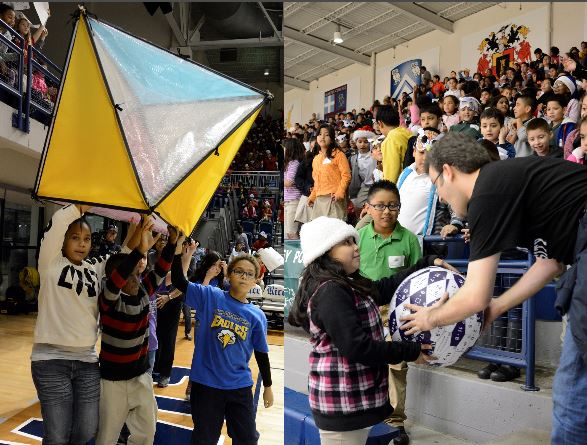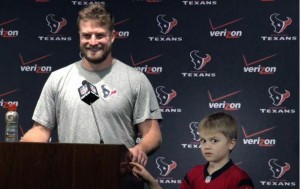By: Dr. Anne Papakonstantinou, Director of the Rice University School Mathematics Project
RUSMP and the Rice Athletics Department collaborated to provide fun and educative mathematics activities for 4,000 3rd- through 5th-grade students from local schools before the Rice men’s basketball game against St. Thomas University on December 18, 2014. The entire RUSMP team led activities for the students which included constructing giant polyhedra using large triangles and computing math problems inscribed on beach balls that were tossed among students in the audience. Students also participated in RUSMP’s famous math tour of the Rice campus virtually.  During the tour, students calculated the age of William Marsh Rice, the university’s founder, at his death. They also described geometric shapes and noted symmetries across the Rice campus. Viewing concentric circles provided an opportunity to expand students’ mathematics vocabulary. Towards the end of the tour, students calculated the number of eyes, beaks, and talons of the three owlets pictured in a popular photo taken by Rice’s Tommy LaVergne.
During the tour, students calculated the age of William Marsh Rice, the university’s founder, at his death. They also described geometric shapes and noted symmetries across the Rice campus. Viewing concentric circles provided an opportunity to expand students’ mathematics vocabulary. Towards the end of the tour, students calculated the number of eyes, beaks, and talons of the three owlets pictured in a popular photo taken by Rice’s Tommy LaVergne.
Mathematics has been at the center of the university since its beginning. Edgar Odell Lovett, a mathematician from Princeton University, was named the first president in 1907. The academic program emphasized mathematics and science supported by humanities from its start. In fact, the very first Ph.D. that was awarded was in mathematics to Hubert Bray who remained to become a mathematics professor at Rice. The first graduating class touted a female mathematician, Lel Red, who went on to become an outstanding mathematics teacher.
RUSMP promotes Rice University’s excellence beyond the hedges in PreK-12 education providing support to precollege institutions across the state. It continues to be the primary catalyst of sustained, progressive change in mathematics education in Houston-area schools and across Texas with its numerous programs for mathematics leaders, teachers, and students and its support to schools and school districts. The December 18th event in Autry court is the latest collaboration to bring mathematics from Rice University to Houston-area students.
Watch a short video of the exciting event below.



